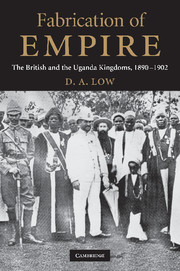Book contents
- Frontmatter
- Contents
- Preface
- List of abbreviations and locations
- Sketch maps
- 1 Prologue: survey and agenda
- 2 Statecraft: external intrusion and local dominion
- 3 Ferment: conversion and revolution in Buganda
- 4 Upcountry: might-have-beens and the Buganda/Uganda outcome
- 5 Warbands: new military formations and ground level imperialism
- 6 Paramountcy: Toro, Busoga and the new overlords
- 7 Defeat: Kabalega's resistance, Mwanga's revolt and the Sudanese mutiny
- 8 Succession: Nkore and the war of Igumira's eye
- 9 Dénouement: aggregations and rulerships
- 10 Government: colonial settlements and the Buganda model
- 11 Capstone: honour, awe and imperialism
- 12 Round up and review
- Select bibliography
- Index
4 - Upcountry: might-have-beens and the Buganda/Uganda outcome
Published online by Cambridge University Press: 04 July 2009
- Frontmatter
- Contents
- Preface
- List of abbreviations and locations
- Sketch maps
- 1 Prologue: survey and agenda
- 2 Statecraft: external intrusion and local dominion
- 3 Ferment: conversion and revolution in Buganda
- 4 Upcountry: might-have-beens and the Buganda/Uganda outcome
- 5 Warbands: new military formations and ground level imperialism
- 6 Paramountcy: Toro, Busoga and the new overlords
- 7 Defeat: Kabalega's resistance, Mwanga's revolt and the Sudanese mutiny
- 8 Succession: Nkore and the war of Igumira's eye
- 9 Dénouement: aggregations and rulerships
- 10 Government: colonial settlements and the Buganda model
- 11 Capstone: honour, awe and imperialism
- 12 Round up and review
- Select bibliography
- Index
Summary
It is now time to turn to the other side of this story – the British side, and in so doing to ask in a quite precise way three questions about the distinctive impress they made on the headwaters of the Nile during the course of the 1890s.
How was it for a start that it was the British who established their separate dominion over this region when a number of other possibilities had variously been mooted?
How then was it that under their aegis there came to be established a relatively small, oddly bounded, separately demarcated, inland polity – which came to be called ‘Uganda’ – which was completely devoid of anything pre-ordained about it?
And then how was it that as this new polity came into being its node should have come to lie in the kingdom of Buganda when a number of other eventualities could conceivably have come to pass?
The first chapter variously canvassed some of the issues here, not least some of the more extreme alternatives, such as some aggregration of the whole range of kingdoms, from Burundi in the south to Bunyoro in the north. Those, however, were only preliminary remarks, and the present chapter will seek to elaborate upon these issues much more extensively. It will not do so by collating the answers to each question in turn. Not only is that not how they eventuated; occurrences relating to one question frequently intermeshed with those concerning others.
- Type
- Chapter
- Information
- Fabrication of EmpireThe British and the Uganda Kingdoms, 1890–1902, pp. 86 - 126Publisher: Cambridge University PressPrint publication year: 2009



